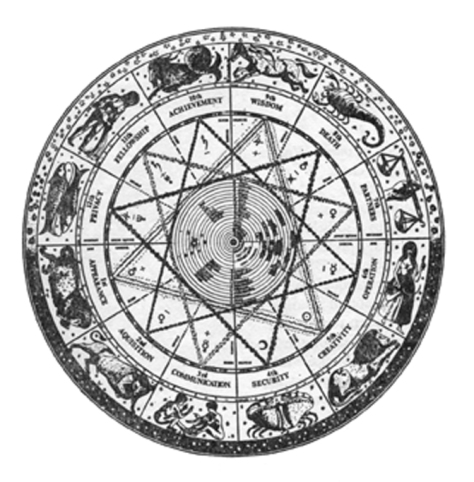The concepts of a personal God, and of an impersonal super-cosmic or intra-cosmic Absolute, represent two ways of solving the problem of the meaning of existence. The former makes astrology quite superfluous, for the solution of all existential problems is “union with God” — or at least the ability to hold a “dialogue” with God, the absolute and never-failing Guide and Comforter. If, however, the universe is understood to exist through the cyclic interplay of cosmic Principles and of an “infinite Ocean of energy” astrology can be considered as a “celestial Language”.
Dane Rudhyar, “The Spiritual Value of Astrology“
I have to admit that, in all my forty-seven years — despite growing up in the Presbyterian Church the son of a preacher — I’ve not been able to wrap my head around the notion of a personal God.
Now, a personal representative of God — that has made more sense to me.
As has the idea of “union” with That… although it’s hard to say that my experience of That is what they (the various scripture writers down through the ages) were referring to when they uttered a name for God.
From my perspective, a universally-acceptable definition of God remains out of reach — as does the absolute certainty that there exists such a Being as God, regardless of the definition.
I mean, does the samadhi of deep meditation equal God?
If I pray intensely and am overwhelmed “by the Spirit,” does this experience prove the existence of God… or does it prove the existence of ecstatic phenomena, without reference to an Ultimate Being?
Perhaps this is the reason why the Buddha left open the question of God, preferring instead to lay out a Path that would eliminate the need for conjecture.
Leaving aside the absolutist assertions of various revealed scriptures that have come down to us, let us suspend our arguments for and against the notion of God, and agree to entertain the idea that individual human beings — beings with a separate consciousness and identity from the Infinite — are incapable of truly “knowing” the Infinite… but that, within our limited range of possible understanding, there may be inspiring clues as to how our world may look from the perspective of God.
There is something of this in what Rudhyar was getting at in his quote.
He was not exactly denying that God could exist in a personal form, or that we humans may “lose ourselves” in this God through a type of spiritual union. In pointing toward a “Celestial Language,” however, he invited us to avail ourselves of an expression of Intelligence that may be decoded through a study of the relationship between our geocentric perspective and the heavens above.
If, indeed, humans were “created in the image” of the Elohim, it stands to reason that there is some correlation between the skies above (representing the outside-looking-in point-of-view of a God with omniscience, omnipresence and omnipotence) and the Earth below, along with its human inhabitants.
Most practicing astrologers would say that there is more than “some correlation,” but that a solid astrological understanding equals a profound opportunity to observe human life through the very eyes of the Celestial God.
* * *
For the record, I have a belief in a Unified Intelligence that “communicates” through many Mysteries… most of which remain encumbered in a morass of disinformation, power games, ignorance and confusion.
I believe that astrology is a valid “decoding machine” for the Mysteries, although a given interpretation is susceptible to fallible human bias. If such bias is an unavoidable consequence of human life, then the question arises: what sort of astrologer offers a bias most aligned with the Source of Celestial Language?
If a given astrologer comes predominantly from an intellectual/technical life-experience, with no direct (i.e., “ecstatic”) absorption in the all-pervading Divine, then this person’s consultation will offer all sorts of bells and whistles dug from a well-read bag o’ astrological tricks. I believe there is value in receiving a reading from such a technician, in that the client benefits from the combined portfolio of every astrologer to whom our technician has ever been exposed. There is good and interesting information here… minus a “living bridge” that vivifies the consultation through the astrologer’s experience of spiritual union.
In modern times — thank goodness — many astrologers maintain daily spiritual practices, some of which are bound to produce ecstatic fruit.
Maurice Fernandez, for instance, is a certified kundalini yoga teacher (in the Yogi Bhajan lineage). I have personally attended some of his kundalini yoga sessions, and am willing to testify to the effectiveness of this practice in giving rise to charismatic phenomena. The “third-eye focus” that is so strongly emphasized during a kundalini yoga session brings an assortment of ecstacies, especially with all the intense “fire breathing” and other techniques that pepper a given yoga set.
A reading from Maurice is naturally informed by his spiritual practice, thus offering a living quality to the Mysteries that speak through the Celestial Language of astrology.
I believe, also, that my own experience as an ecstatic contemplative brings a profound connection with astrological information in a way that no book or lecturer could ever provide.
I say this not to toot my own horn, but to strongly hint that the counseling device of astrology — which purports to give insight (at the very least) into universal laws that are God-like in perspective — is nothing but rote recital when devoid of a unitive spiritual practice.
You want your astrologer, in other words, to be able to combine solid astrological understanding with a rigorous practice that brings spiritual authority to the expressions of Celestial Language.
You want to get yourself an astrologer who not only understands the Celestial Language, but who speaks it through the filter of daily “union with God” — beyond the need for conjecture.





